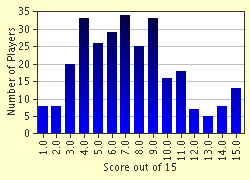Quiz Answer Key and Fun Facts
1. When the WWII started, who was the president of Poland?
2. When the war started, what was the proportion of infantry between the German and the Polish army?
3. Hitler demanded Sudetenland from Czechoslovakia and he received it. Hitler demanded Memel (Klaipeda) from Lithuania and he received it, too. Hitler demanded _____ from Poland and received nothing, so he started the war. What were his demands on Poland?
4. This Polish naval base and a strongpoint on country's only peninsula resisted until October 2nd 1939, despite the capitulation of Warsaw. What's the name of this place, now a fishing harbour?
5. On September 1st, a Polish submarine was on a patrol. When the communication with the headquarters was cut off, the captain decided to go to Tallinn in Estonia, so they could repair the submarine and wait for new orders. When the submarine arrived at Tallinn, the crew was interned and the submarine was to disarm, what was illegal according to the Naval Law. However, the crew freed themselves, boarded the submarine and managed to escape from Tallinn to England. What was the name of that submarine?
6. This was Polish regular unit's first battle after the end of September Campaign. In 1940, SBSPodh. (Podhale Fusiliers Independent Brigade), Polish elite alpine unit, was a part of Allied forces landing in north Norway. What is the name of the port where they landed?
7. During the Battle of Britain, despite joining it only in mid-September, this famous Polish unit was one of the best Allied fighter squadrons, shooting down 93 German planes. What was the unit's name?
8. Polish volunteers joined Russian Red Army in December 1939 to fight against Nazi Finland.
9. Polish Army formed in the USSR according to Sikorski-Majski pact left Soviet Union and joined British 8th Army in North Africa. Their biggest success and most known action was capturing and then - together with Australian units - defending a very important port and fortress, situated in today's eastern Libya. What's the name of this town?
10. Who was the Commander-in-Chief of the Polish Armed Forces and the Prime Minister of Polish Exile Government until 1943, when he died in a plane accident in Gibraltar, on July 4?
11. Who was the commander of the only Polish armoured division formed in Britain that fought in France (Falaise-Chabrois), The Netherlands and Germany?
12. Was there any Polish Airbone unit during the war?
13. What is the name of a monastery in central Italy, from which well-entrenched German paratroopers ("Green Devils") were blocking the road to Rome? The hill and monastery were taken by a Polish assault, after the British, French, American and Canadian had failed to do so.
14. What was the name of the underground organisation that prepared the most dramatic uprising in that war, the Warsaw Uprising?
15. When was Warsaw 'liberated' by the Soviets?
Source: Author
Jurek86
This quiz was reviewed by FunTrivia editor
Beatka before going online.
Any errors found in FunTrivia content are routinely corrected through our feedback system.

